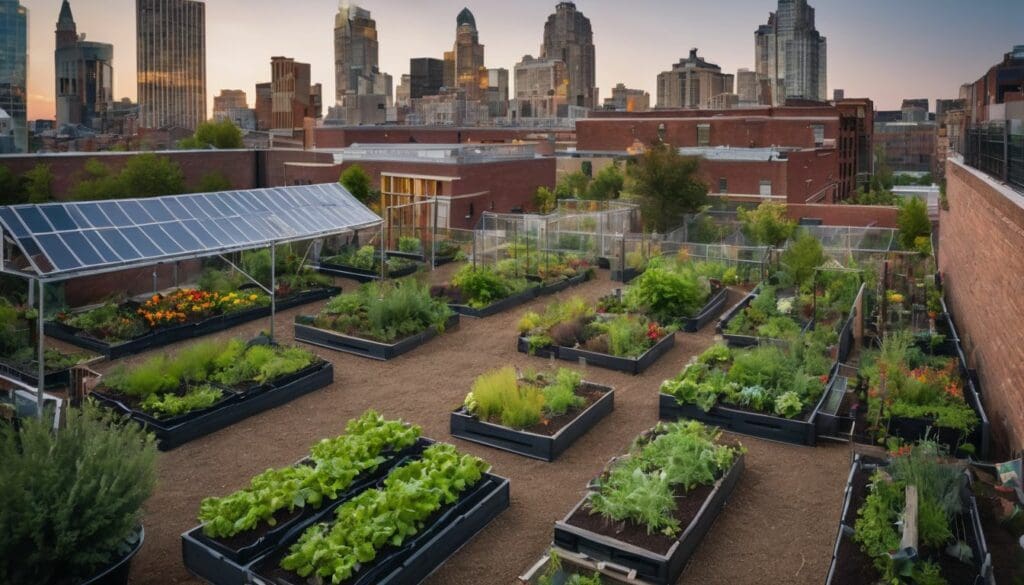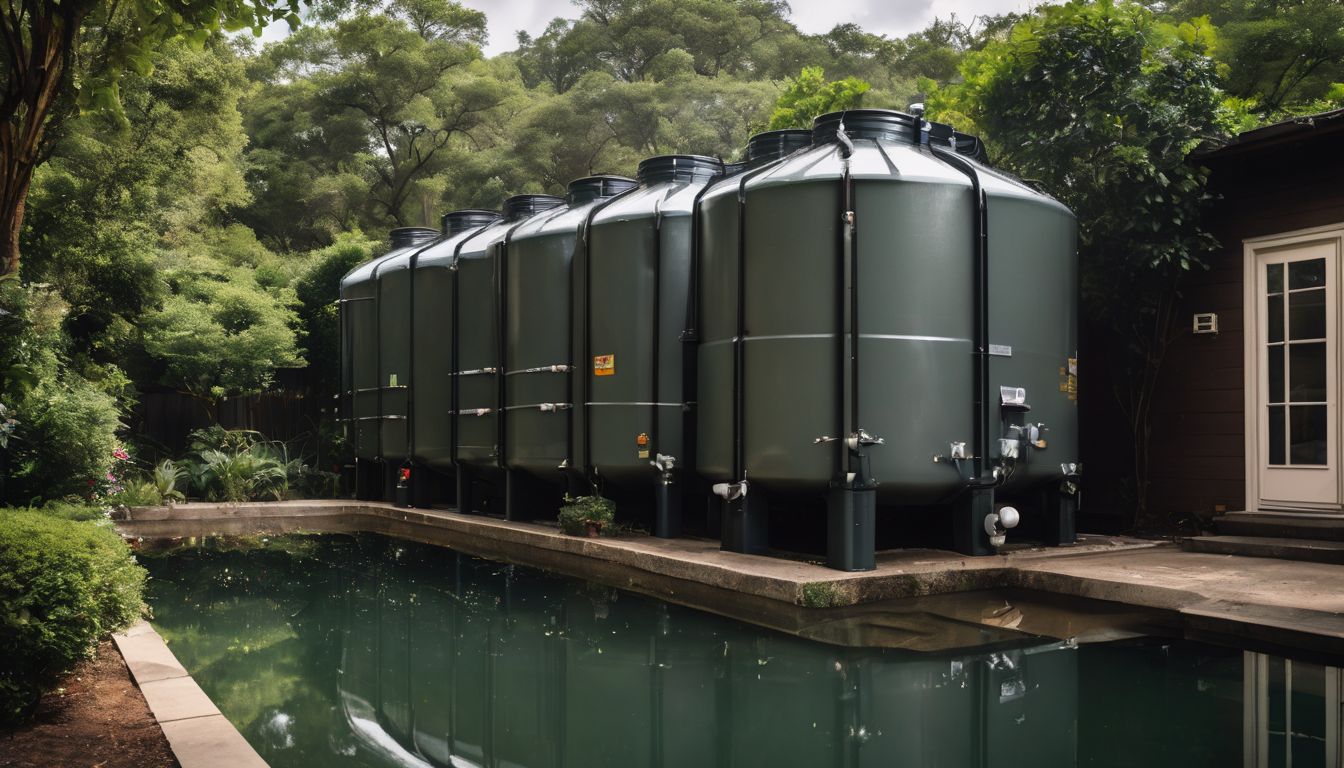Communities everywhere are seeking ways to flourish while respecting our planet. A staggering 70% of global carbon emissions come from cities, signalling an urgent need for action at the community level.
This article outlines a clear, step-by-step approach to crafting a Sustainable Community Action Plan that can transform your local area into a beacon of sustainability. Dive in and discover how you can make real change happen!
Key Takeaways
- A Sustainable Community Action Plan is a strategic blueprint for achieving sustainability goals, focusing on environmental conservation, social change and economic development within local areas.
- It’s vital to involve the entire community in crafting this plan; engaging with local residents, businesses, government agencies and environmental groups ensures diverse perspectives are included.
- The process involves establishing clear benchmarks and goals, identifying stakeholders who will contribute to the planning process and conducting thorough sustainability assessments of current conditions.
- To effectively implement a sustainable action plan, communities should develop targeted strategies such as promoting renewable energy sources, implementing recycling programs and encouraging sustainable transportation methods.
- Collaboration and partnerships with various community entities boost the success rate of sustainability initiatives by combining resources and expertise.
What is a Sustainability Action Plan?
A Sustainability Action Plan is a strategic roadmap for achieving sustainability goals within a community. It outlines specific initiatives and actions to address environmental, social, and economic challenges while promoting long-term sustainable development.
Definition and purpose
A Sustainability Action Plan outlines a community’s approach to achieving environmental sustainability. This blueprint maps out strategies for conserving resources, promoting sustainable design and building resilient communities.
Its purpose stretches beyond preserving natural habitats; it aims to foster economic development, social change and enhance the overall quality of life.
Crafting such a plan requires identifying critical areas where action is necessary—for instance, waste reduction, sustainable housing or green initiatives. It then sets clear objectives and defines steps towards creating a more sustainable and vibrant community.
By focusing on local initiatives, education programmes and reinvestment strategies, the plan serves as a roadmap for long-term community revitalisation efforts that benefit both people and the planet.
Importance of having a sustainability action plan
Having a sustainability action plan is crucial for creating positive change within our communities. It provides a roadmap for addressing key sustainability issues, such as environmental quality, social impact, and community development.
Through the implementation of this plan, we can work towards affordable housing, workforce development, education initiatives, and environmental stewardship. By involving the community in these efforts and fostering collaboration and partnerships, we can collectively strive towards sustainable living.
Creating a sustainability action plan empowers us to take tangible steps towards improving our communities. This proactive approach not only benefits the environment but also has a direct impact on the well-being of residents.
How to Create a Sustainability Action Plan
To create a sustainability action plan, start by establishing clear benchmarks and goals. Identify key stakeholders who will play a role in the process, conduct a thorough sustainability assessment of the community, and develop an action plan based on your findings.
Establishing benchmarks and goals
To establish benchmarks and goals, the community must first identify key areas of focus. This involves setting clear objectives for sustainability initiatives and determining measurable targets.
Engaging with stakeholders is crucial in this process to ensure that the benchmarks align with community needs and priorities. Once these benchmarks are established, it is essential to develop realistic timelines for achieving each goal.
Regular monitoring and evaluation will be necessary to track progress and make adjustments as needed. By establishing clear benchmarks and goals, the community can effectively measure its progress towards creating a sustainable action plan.
Additionally, articulating specific targets creates accountability among stakeholders. It provides a framework for decision-making, resource allocation, and prioritisation of actions that support sustainable outcomes.
Identifying key stakeholders
Identifying key stakeholders is crucial when creating a sustainability action plan. This step involves recognising individuals, groups, and organisations that will be affected by or can influence the plan’s implementation.
Engaging with local residents, businesses, government agencies, and environmental groups ensures that diverse perspectives are considered in the decision-making process. Collaborating with these stakeholders helps to build support for the action plan and increases its chances of success.
Involving key stakeholders from the outset fosters a sense of ownership and commitment to the sustainability action plan. This active engagement also allows for valuable input and expertise to be integrated into the development of effective strategies tailored to address specific community needs.
Conducting a sustainability assessment
After identifying key stakeholders, the next step in creating a sustainable community action plan involves conducting a sustainability assessment. This process evaluates the current environmental, social, and economic conditions within the community.
It helps identify areas that require improvement and opportunities for positive change. Conducting a sustainability assessment enables community members to gain a comprehensive understanding of their impact on the environment and society, paving the way for informed decision-making.
By conducting these assessments regularly, communities can track progress towards their sustainability goals and adjust strategies as needed. Involving various stakeholders in this process ensures diverse perspectives are considered, leading to more inclusive and effective action plans aligned with community needs and values.
Developing an action plan
To develop an action plan for creating a sustainable community, start by establishing clear benchmarks and goals. Identify key stakeholders within the community who can contribute to the planning process.
Conduct a comprehensive sustainability assessment to understand the current state and identify areas for improvement. Then, proceed with outlining specific initiatives and strategies that address key sustainability issues identified during the assessment.
Ensure that there is a well-defined implementation plan in place, followed by mechanisms for monitoring progress and evaluating outcomes.
Creating a sustainable community action plan requires proactive involvement from everyone interested in promoting environmental conservation, urban planning, and community development.
Components of a Sustainability Action Plan
Identifying key sustainability issues, developing strategies and initiatives to address them, creating an implementation plan, and establishing monitoring and evaluation processes.
Read more on the importance of each component in creating a sustainable community action plan.
https://www.youtube.com/watch?v=el2Q3iWoBfs
Identifying key sustainability issues
Identifying key sustainability issues involves examining various aspects of the community to pinpoint areas that require attention or improvement. This process is crucial for understanding the specific challenges and opportunities for sustainable development within the community.
- Environmental impact assessment: Evaluating the direct and indirect effects of human activities on the environment, such as air and water quality, waste management, and conservation of natural resources.
- Social equity considerations: Identifying disparities in access to resources, services, and opportunities among different groups within the community, including issues related to affordable housing, education, and healthcare.
- Economic sustainability analysis: Assessing the economic vitality of the community by examining factors like employment opportunities, local businesses, income distribution, and economic resilience.
- Climate change adaptation and resilience: Understanding the vulnerabilities of the community to climate-related risks such as extreme weather events, rising sea levels, and changing precipitation patterns.
- Biodiversity preservation: Recognising the importance of protecting and enhancing biodiversity through conservation efforts in urban green spaces, wildlife habitats, and protected areas.
- Energy efficiency and renewable energy adoption: Identifying opportunities to reduce energy consumption and promote renewable energy sources to mitigate greenhouse gas emissions while improving energy security.
Strategies and initiatives to address them
To address key sustainability issues, the community can implement various strategies and initiatives.
- Developing renewable energy sources to reduce reliance on non-renewable resources.
- Implementing waste reduction and recycling programmes to minimise environmental impact.
- Promoting sustainable transportation methods such as carpooling, cycling, and public transport.
- Creating green spaces and promoting biodiversity through tree planting and conservation efforts.
- Adopting sustainable agricultural practices to reduce chemical usage and promote organic farming.
- Educating the community about sustainable living practices through workshops, seminars, and awareness campaigns.
- Engaging in water conservation efforts through efficient use and management of water resources.
- Encouraging responsible consumption and production habits among community members to minimise waste generation.
Implementation plan
With the strategies and initiatives identified, the next crucial step is to develop an implementation plan. This involves outlining specific actions and timelines for addressing key sustainability issues within the community.
The implementation plan should clearly define responsibilities, allocate resources, and establish monitoring mechanisms to ensure progress towards sustainable goals.
To achieve success, a well-crafted implementation plan must involve the active participation of all stakeholders in the community. By engaging diverse voices and leveraging partnerships, the community can effectively drive impactful change while creating a more sustainable future together.
Monitoring and evaluation
Once the sustainability action plan is in place, continuous monitoring and evaluation are crucial. This involves regularly reviewing progress against set benchmarks and goals. Tracking key sustainability indicators allows for adjustments to be made as necessary, ensuring that the plan remains effective in addressing community needs and environmental concerns.
Engaging key stakeholders in the monitoring and evaluation process fosters accountability and transparency within the community. It also provides an opportunity to celebrate successes, identify areas for improvement, and adapt strategies based on real-time feedback from those impacted by the action plan.
Regular evaluation ensures that the community’s efforts towards conservation and environmental protection remain aligned with their goals.
The Role of Community Involvement
Community involvement is crucial for the success of a sustainability action plan, as it ensures that the needs and priorities of the community are taken into account. Collaboration and partnerships with local stakeholders can help to engage the community in sustainable initiatives.
Importance of involving the community
Involving the community is crucial for creating a sustainable action plan. Engaging with local residents, businesses, and organisations ensures that the plan reflects the unique needs and priorities of the community.
By involving the community in the process, stakeholders feel empowered to take ownership of sustainability initiatives, leading to increased participation and support for long-term success.
Collaborating with the community also brings diverse perspectives and expertise to the table, fostering innovation and creative solutions to complex environmental issues. Community involvement builds trust, strengthens social connections, and fosters a sense of shared responsibility for environmental stewardship.
This active engagement fosters a sense of collective pride in contributing towards positive change; it transforms what could be perceived as an individual burden into communal action toward building a more sustainable future.
Collaboration and partnerships
Collaboration and partnerships are essential for the success of a sustainable community action plan. By working together with local businesses, non-profit organisations, and government agencies, we can combine resources and expertise to address sustainability issues effectively.
Partnering with like-minded entities allows us to leverage collective knowledge and skills, leading to innovative solutions that benefit the entire community.
Engaging in collaborations also fosters a sense of shared responsibility among stakeholders, creating a unified front towards achieving sustainable goals. Developing strong partnerships can amplify our impact, expanding outreach and engagement efforts to involve a broader spectrum of individuals who share our commitment to environmental conservation.
Community engagement strategies
To engage the community effectively, consider the following strategies:
- Hosting community workshops to gather input and ideas on sustainability issues.
- Implementing educational programs to raise awareness and promote active participation in sustainable actions.
- Facilitating volunteer opportunities for community members to actively contribute to sustainability initiatives.
- Establishing a communication platform such as a newsletter or social media group to keep the community informed and engaged.
Conclusion: Importance of Creating a Sustainable Community Action Plan and Taking Action.
Developing a sustainable community action plan requires collaboration among key stakeholders. Identifying sustainability issues and implementing strategies are essential for creating positive change.
Community involvement is crucial for the success of the action plan, ensuring long-term environmental benefits. Taking action towards sustainability will cultivate a healthier and more vibrant community for generations to come.
FAQs
1. What is a sustainable community action plan?
A sustainable community action plan is a detailed strategy designed for people to work together on improving their local area in a way that’s good for the environment and society.
2. Why do we need to create a community development plan?
We create a community development plan to guide how we can make our neighbourhoods better places to live, work, and play while also taking care of the planet.
3. Who should be involved in making this action plan?
Everyone! It’s important that all members of the community get involved – from residents to businesses and local authorities – so everyone’s ideas are included.
4. How often should we review our sustainable action plan?
It’s smart to regularly check our action plan, at least once every year, so we can see what’s working well and update anything that needs changing.





